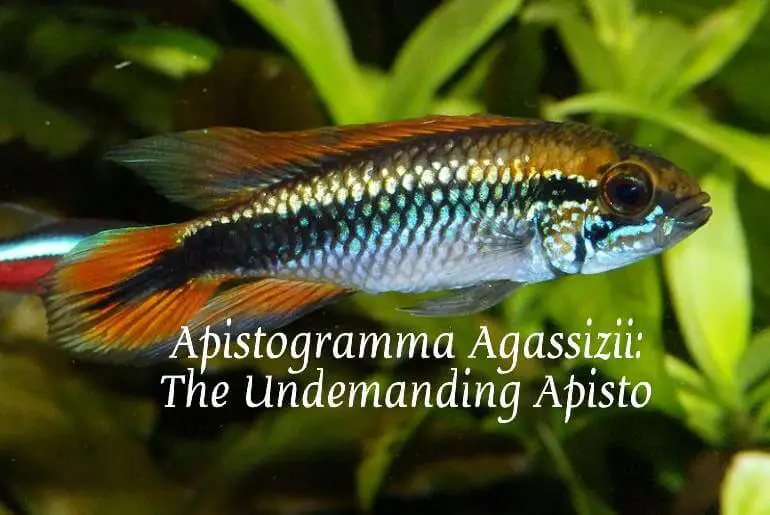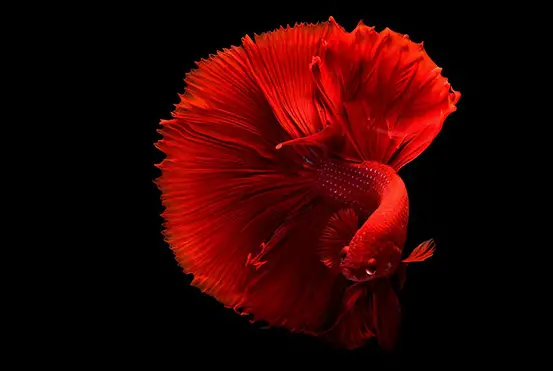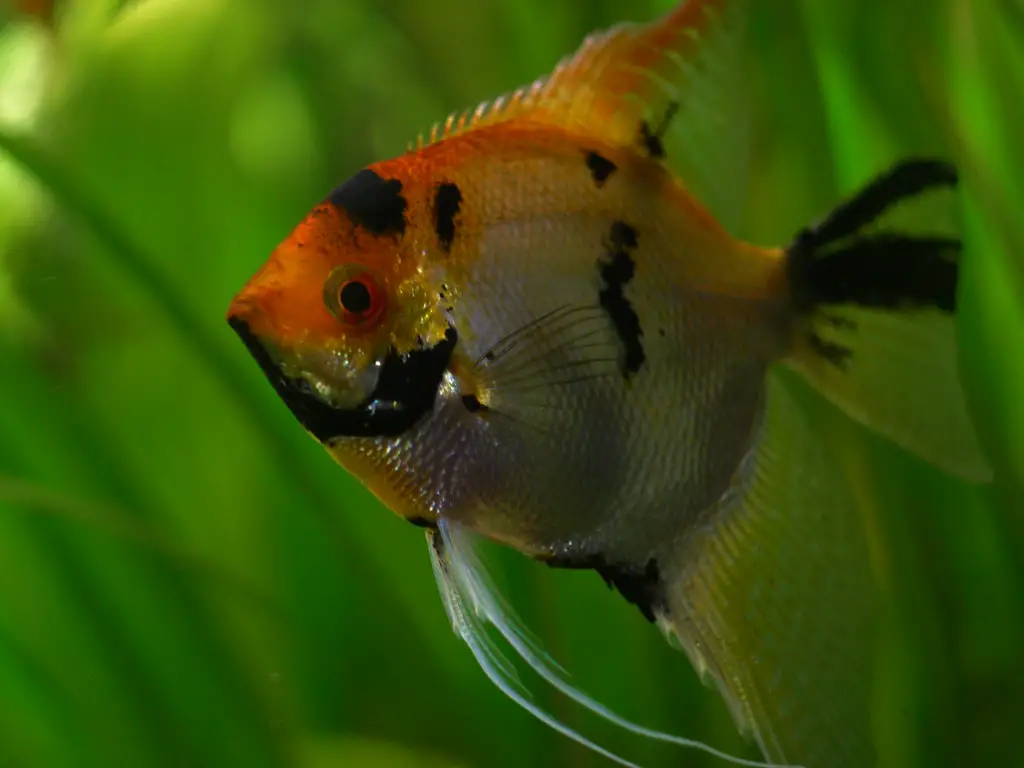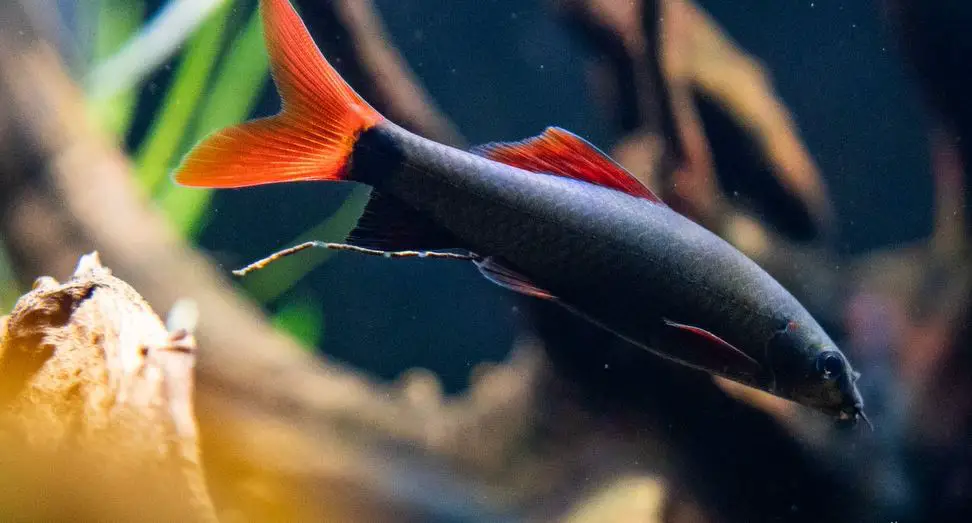If you are a cichlid lover, then there is no doubt about your inclination towards Apistogramma Agassizii or Agassizii’s Dwarf Cichlid. But What are these Apistogramma Agassizii like? How do you care for Apistogramma Agassizii?
Apistogramma agassizii is the group of cichlids commonly known as Agassizii’s dwarf cichlids. They make the ideal option for small tanks as this apistos has an easily manageable size, enchanting behavior, and above all brightest colors.
These Apistogramma Agassizii are so easy to handle and care for and are not even sensitive like other fish making them the most undemanding Apistos.
Even the beginners can have no stress while petting a captive-bred agassizii as they are well-adapted to tank conditions.
But the question doesn’t end here, does it? What factors make Apistogramma agassizii the undemanding apisto? How can you take care of Agassizii’s dwarf cichlids in the tank? What are the ideal tank mates of Agassizii’s dwarf cichlids?
Let’s look through this detailed study to know the answers to every probable question about these dwarf cichlids.
Apistogramma Agassizii: An Overview
Before you know what to do and what not to do with this agassizii, you need to know what they are like, where they come from, what food they prefer, and what type of water they live in.
| Temperament | Shy, not social |
| Lifespan | 8+ years |
| Size | 3 inches for males 2 inches for females |
| Swimming | Middle to the bottom section |
| Availability | Uncommon in pet stores but common online |
Distribution And Habitat Of Apistogramma Agassizii
If there is one thing about the distribution of these A. agassizii then that is their wide range. They have made home a huge range of water conditions while they live in the wild.
The widespread distribution starts from the Amazon basin in Peru to Capim River Basin in Brazil. Agassizii inhabits the slow-moving, shallow blackwater creeks and tributaries.
The upper section of the Amazon basin in Rio Ucayali, Peru ranging into the brazil along with the capim river to a tributary of Rio Guama. Likewise, Rio Guama flows into Rio Para located at Belem city in the Amazon delta region houses various varieties of agassizii.
Most of them, with no doubt, are well-adapted to this variety of water conditions helping them to adjust to any water conditions in captivity.
The environment they live in in the wild is quite darker filled with leaf litters. Likewise, leaf litter is accompanied by fallen branches.
The Amazon basin, be it the upper or delta region, have lots of nooks and crannies giving enough space for these fish to hide.
Also, all the agassizii fish you get online as they are always short in pet stores, are captive-bred, and are adapted to all water range.
They are even compatible with less acidic water due to their years of captive breeding.
Tank Requirements For Apistogramma Agassizii
Although they don’t demand much, you need to make sure what you need to provide them. Here are the things you need to look at when you plan to get Apistogramma agassizii:
| Tank size | 10 gallons |
| Temperature | 72 to 85 °F |
| pH range | 4 to 6.5 |
| Hardness | 0 to 10 dKH |
The minimum tank size to keep one mated pair of these dwarf cichlids is 10 gallons. Any less than this can cause issues for both fish present in the tank.
Likewise, the issues can also occur in the absence of a heater that keeps the temperature ideal at 72 to 85 °F.
They do prefer acidic water but captive-bred can adjust well in slightly different pH ranges as well. You need to remember to maintain the pH and hardness of the water for your agassizii fish.
Filter and heater are two of the most important types of equipment that you’ll need in the Apistos tank.
Apistogramma Agassizii Diet
Apistogramma agassizii is one of the well-known carnivore fish that devours both live and frozen meat.
You can go with blackworms to bloodworms while feeding agassizii fish. Along with that, they can eat mosquito larvae, daphnia, scuds, brine shrimp, tubifex, and white worms.
If you have captive-bred (mostly they are captive-bred) then there is a chance that they will devour micropellets and flakes as well.
You might also like Fish Food 101: A Beginner’s Guide On How To Feed Aquarium Fish
Best Tank Mates For Apistogramma Agassizii
These A. agassizii fish are quite compatible with any fish but the following lit tops the list with their friendly and peaceful nature mostly.
Neon Tetras
| Temperature | 70 to 83 °F |
| pH | 4 to 7.5 |
| Temperament | Peaceful Schooling fish |
| Hardness | 1 to 12 dKH |
| Size | 1.5 inches |
| School size | more than 6 members |
| Diet | Omnivores |
| Swimming | Mid to top |
The neon tetra is one of the ideal tankmates for most of the fish due to its peaceful and non-aggressive nature.
They also belong to the Amazon basin with blackwater parameters making them easier to adjust in agassizii tank.
Black Neon Tetra
| Temperature | 73 to 81 °F |
| pH | 4 to 7.5 |
| Temperament | Peaceful Schooling fish |
| Hardness | 4 to 9 dKH |
| Size | 1.5 inches |
| School size | more than 8 members |
| Diet | Omnivores |
| Swimming | Mid to top |
The black Neon tetra is often mistaken with neon tetra but the color they both bear is huge parameters to separate them.
Their color may be different but they don’t show much difference in their nature. They have quite similar features and prefer nearly the same water parameters.
So, these black neon tetras, like neon tetras, make ideal tank mates for agassizii fish.
Pencilfish
| Temperature | 74 to 82 °F |
| pH | 5 to 7 |
| Temperament | Peaceful Schooling fish |
| Hardness | 4 to 12 dKH |
| Size | 2 inches |
| School size | more than 6 members |
| Diet | Omnivores |
| Swimming | Mid to top |
You have nearly 16 types of this peaceful schooling fish to choose from to keep along with this apistos fish in the agassizii tank.
The care level is so easy, all you have to do is give them a school with at least 6 members.
Leopard Danio
| Temperature | 64 to 75 °F |
| pH | 6 to 8 |
| Temperament | Peaceful Schooling active fish |
| Hardness | 2 to 20 dKH |
| Size | 2.4 inches |
| School size | more than 6 members |
| Diet | Omnivores |
| Swimming | Mid to top |
These leopard print fish are quite easy to care for and won’t disturb your agassizii fish at all. They will remain with their school and swim around without bothering other fish.
Zebra Danio
| Temperature | 65 to 77 °F |
| pH | 6 to 8 |
| Temperament | Peaceful active Schooling fish |
| Hardness | 5 to 20 dKH |
| Size | 1.5 to 2 inches |
| School size | more than 6 members |
| Diet | Omnivores |
| Swimming | Mid to top |
These small danio fish can adjust to a wide range of water conditions making it appropriate to live with agassizii fish.
Zebra danio is peaceful yet active and prefers to swim around with their school with at least 6 members.
Norman’s Lampeye Killifish
| Temperature | 73 to 78 °F |
| pH | 6 to 7 |
| Temperament | Peaceful active Schooling fish |
| Hardness | 4 to 15 dKH |
| Size | 1.6 inches |
| School size | more than 9 members |
| Diet | Omnivores |
| Swimming | Mid to top |
These blue-eyed fish add glow to the tank with their glowing and spectacular eyes. Lampeye, as their name states, have eyes that glow so beautifully in dark.
Also, their peaceful and schooling nature keeps them busy within them without causing any disturbance to other fish present in the tank.
Clown Killi
| Temperature | 68 to 79 °F |
| pH | 4 to 7 |
| Temperament | Peaceful active Schooling fish |
| Hardness | 1 to 8 dKH |
| Size | 1.3 inches |
| School size | more than 8 or 10 members |
| Diet | Omnivores |
| Swimming | Mid to top |
Every peaceful fish can go well in the agassizii’s tank without causing any issues and riots. The same is the case with clown killi.
These small rocket killis are not only beautiful to look at but also add extra beauty to the tank as well. The water parameters also help them to adjust in the tank along with Apistogramma agassizii.
Types Of Apistogramma Agassizii On The Basis Of Their Color Variants
The location where these fish are found also determines their coloration and there is a huge range of color morphs that can’t be found in wild as well.
There are lots of Apistogramma fish you can choose from based on their color, here is a list of a few of them.
Fire Red
The most popular color among these species of apistos is probably the Fire Red one although pet stores don’t prefer keeping Apistogramma much.
Fire Gold
As the name states, these might be the cross from fire reds, and a new addition to the variant. These seem like a fire red but are more yellowish or say goldish.
Super Red
There are so many varieties when it comes to the color red. There is super red to super fire red, even a discovery of aspito fish with dark orange color is kept under super red ones.
So, you need to look carefully for the picture of super red and ask the pet store, especially for the super red original ones. This way you will have a beautiful fish with vibrant red color for your tank.
Blue
These Apistogramma agassizii are quite confused with Tefe Blue and Rio tefe blue, although these are quite different. The shade of color varies from Apistogramma agassizii’s species with tefe color.
Tefe
There are more than 5 variants of this Apisto that fall under the same category as tefe. That goes from tefe to Rio tefe blue and many more.
These Apistogramma tefes are quite a locale depending on the place they are collected from.
Redback
As already stated, the variant of tefe ranges up to 5 or more types, and redback is one of them. it is also popularly called tefe redback and often sold in place of original tefe.
These are also called as hybrid and sold to people, although it isn’t.
Apistogramma Agassizii Diseases
As these agassiziis are not demanding in the medicinal sector as well, it is wise to stock up medicines for common fish diseases.
Agassizii is not quite susceptible to these diseases, but having a look at them doesn’t do much harm:
Ich
The most common disease among fish is white spot disease, which is also known as ich. The ciliate protozoan Ichthyophthirius multifiliis is the causative agent of this disease that causes small, blister-like raised lesions around the skin, gills, fins, and moth of fish.
It seems like a pimple all around the body and is also one of the main diseases that can infect your Agassizii.
Symptoms:
- Scratching
- Pimple-like white spots
- Bloody streaks or Redness
Causes:
Ichthyophthirius multifiliis
Fungal Infection
A huge family with huge varieties of species of fungus bring fungal infection in the fish and nearly shows similar symptoms as a bacterial infection.
Two medicines, namely Ich X and Erythromycin, can treat any of the disease-related to fungus or bacteria.
Symptoms:
- Cotton like growth on body parts like fins, eyes, gills, or body.
Causes:
- Stress
- Poor water quality
- Prior Untreated Injury
- Previous fungal infection
Bacterial Infection
Bacteria are quite common in the tank and don’t harm fish unless the tank provides them a favorable environment.
But the broad spectrum of antibacterial can help you overcome this problem once you do the harder job of noticing the infection.
Causes:
- Poor Water conditions
- Rotten Food
- Stress
- Water parameters way off from the ideal condition
Symptoms:
- Red Ulcers
- Popeye
- Red streaks
- Bloating
- Unclear Growth
Costia
A small parasite namely Ichthyobodo causes this costia disease in the fish. This disease is common among cold-water fish, so your only mistake to invite this into your tank is letting the temperature drop.
Among the parasitic variety that infects fish skin, this one is impossible to detect in the initial stage. After a few months though you can clearly see the symptoms and may be quite late to take action against this costia nightmare.
Causes:
- Protozoa named Ichthyobodo
Symptoms:
- White or grey patches in the skin
- Scratching
- Itching
Skin And Gill Flukes
Flukes are generally present in almost every tank. They are dormant in the normal water conditions but infect fish as soon as the water parameters change or deteriorate.
Causes:
- Stress
- Prior illness
- Poor water parameters
- Overcrowding
Symptoms:
- Gills and skin start turning red
- Constant itching
- Gasping
- Excessive mucus on the skin
Tapeworm
Tapeworms are a way more serious issue than you take it as. These worms grow longer and longer but come out in a very small segment from your fish’s anus.
Their small size and segments make it hard to notice and diagnose in the fish.
Causes
- Transmits from other infected fish
Symptoms
- Inability to grow
- Sunken stomach
- Withering
Breeding Of Apistogramma Agassizii
The breeding of Agassizii is quite interesting as 1 male takes care of 4 to 7 females, so these fish are famously termed as harem breeders.
The water parameters should be strictly followed in the breeding tank. If you have two males in the tank, it is better to get a 50-gallons tank with soft and acidic water.
You might also like How To Set A 50-Gallon Fish Tank?
Likewise, the temperature should be a little higher than the normal tank, nearly to the upper range of their ideal temperature.
The following steps take place further in the breeding tank:
Signaling
After all the set-up, the most fascinating part is the signal that the female sends to the male agassizii. The female turns themselves yellow showing their stomach to let the male fish know.
Cave Seeking
After the signal is received, females seek a cave-like structure and the male seeks it. You can get pots like terracotta with drilled holes to give cave to these fish.
The ideal size hole in the terracotta pot should be less than your thumb but large enough for the female to enter.
Laying Eggs
After settling down in the cave the male chose for her, the female lays around 150 eggs on the roof. After the eggs are laid, the male releases the sperm and waft it inside the cave with the help of his tail.
The female will remain there to guard the eggs whereas the male member will guard the harem territory.
Eggs hatching and Guard
After 2 to 4 days, the eggs will hatch depending on the water temperature. The female will still guard these small wrigglers for few more days till they are strong enough to go outside.
Once she sees them capable, she will send these fries out of the cave, although she will still be fending off any predators.
Fight Between Male Apistogramma Agassizii and Female Apistogramma Agassizii
Male fish, at this point, act as a predator as well, so the female agassizii will bully it off and sometimes die in this process as well. So, it is wise to remove male fish from the tank after spawning to save the female fish.
Feeding
On the other hand, the fry will need enough food to grow faster, so baby brine shrimp can be a good diet for them. But you need to remember they are small fries and should be fed in appropriately small size only.
I have also written an article on
Frequently Asked Questions
Is Apistogramma Agassizii A Community Fish?
Yes, they are kept under the community fish category as these Apistos can live well with other fish and their partner too.
Is Apistogramma Agassizii Aggressive?
Yes and no. Yes, because they can have mood swings and can be aggressive sometimes but no as they are nicknamed for their semi-aggressive temperament.
Conclusion
Briefly, if you are a beginner and have no idea about fish keeping, even then you can get these agassizii’s dwarf cichlids. They are so easy to care for and have very less or no extra demands. Likewise, you can keep them in less acidic water when this Apistogramma Agassizii is captive-bred. They will adjust to the water as if they belong there. Moreover, you don’t even need a whole school of these, a pair of companions can do way better in the tank as they are not very social and need a partner for companionship only.
Recommended Articles:






